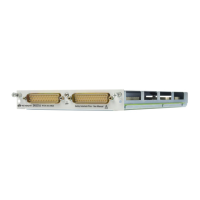Keysight 34921A-34925A Low Frequency Multiplexer Modules User’s Guide 11
Low Frequency Multiplexer Modules
Operating Considerations
Current Ratin
gs
See the Introduction to the Plug In Modules chapter of the 34980A Mainframe
User’s Guide for detailed environmental operating conditions for the 34980A
mainframe and its installed modules. That guidance sets maximum per channel
current ratings at rated voltage for pollution degree 1 (dry) and pollution degree
2 (possible condensation) conditions, for all of the multiplexer modules.
Safety Interlock
The Analog Buses of the 34980A are capable of carrying 300V signals. The MUX
modules have a hardware Safety Interlock feature that automatically opens the
Analog Bus relays when the associated interlock pins on the D-sub connectors
(faceplate) lose continuity. This prevents signals on the Analog Buses from being
present on the D-sub connector pins. Optional terminal blocks available from
Keysight automatically provide continuity for these interlock pins. If cables are
used, you must provide continuity for the interlock pins in your DUT assembly.
See the pinout information later in this guide for the location of interlock pins on
each module.
The MUX modules have Analog Bus relays on each of their two banks. Therefore,
the interlock pins are present on both the Bank 1 and Bank 2 D-sub connectors
on the MUX modules.
Normally, if you attempt to connect to the Analog Buses without a terminal block
or cable connected, an error is generated. The
SYSTem:ABUS:INTerlock:SIMulate command allows you to temporarily
disable errors generated by the Safety Interlock feature and enables the
simulation mode. Although Safety Interlock errors are suppressed in this mode,
the actual Analog Bus relays affected by the Safety Interlock are disabled as long
as no terminal block or cable is connected to the module.
- The simulation mode applies to the entire mainframe and cannot be
selectively used on individual modules.
- When the simulation mode is enabled, the Analog Bus relays will appear to
close and open as directed. For example, no errors are generated if you close
an Analog Bus relay from the front panel, remote interface, or Web Interface.
However, remember that the Safety Interlock feature prevents the actual
hardware state of the Analog Bus relays from being changed. When you
connect a terminal block or cable to the module, the Analog Bus relays will be
closed.
- The simulation setting is stored in volatile memory and will be lost when
power is turned off. To re-enable the simulation mode after power has been
off, you must send the command again.
The Safety Interlock feature is implemented in hardware on the
modules and cannot be circumvented. Regardless of whether the
simulation mode is enabled or disabled, all Analog Bus
connections are prohibited as long as no terminal block or
properly-wired cable is connected to the module.
Artisan Technology Group - Quality Instrumentation ... Guaranteed | (888) 88-SOURCE | www.artisantg.com

